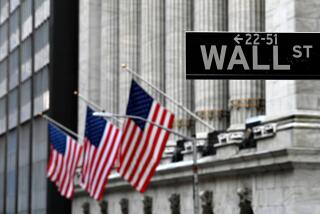Investing: Charles Schwab likely to benefit as clients return to stocks
Question: What are the prospects for my stock in Charles Schwab Corp.?
Answer: You don’t need to “Ask Chuck” to know that the deep economic downturn and bear market in stocks weren’t kind to brokerage firms.
Fees dropped as asset values plunged and investors fled any kind of risk. Because the Federal Reserve dropped short-term interest rates to near zero, Schwab, like other firms that manage mutual funds, has had to waive fees on its money market funds to avoid losses for investors.
Schwab, however, has been seeing clients move money out of cash and into securities, and stands to benefit if the investment climate shows further improvement. And interest rates are expected to rise as the economy improves.
Revenue at the country’s largest discount brokerage rose slightly last year to $4.3 billion, but profit sank 42% to $454 million. Both results were well below their 2008 and 2009 levels.
In the first quarter of 2010, Schwab earned $243 million, compared with $6 million a year earlier.
Though the San Francisco company’s stock price is up 2.5% this year, it remains down one-third from its September 2008 peak.
To spur growth, the firm is buying options brokerage OptionsXpress Holdings Inc. for about $1 billion in stock.
Schwab also plans this year to open offices run by independent brokers in smaller communities to augment its existing employee-operated branches and client service centers.
The company has a fast-growing business in exchange-traded funds, with plans to offer all-ETF 401(k) plans.
Schwab has more cash than debt on its balance sheet, and it plans to increase its capital spending by 40% this year.
Wall Street analyst ratings on Schwab’s stock consist of three “strong buy” grades, 10 “buys” and eight “holds,” according to Thomson Reuters.
Fidelity Fund sticks close to S&P index
Question: Should I keep my money in Fidelity Fund or move it elsewhere?
Answer: Because its $6.1-billion portfolio resembles the Standard & Poor’s 500 stock index, it is difficult for this fund to be a standout.
John Avery, who has run the fund since 2002, keeps its overall sector weightings close to those of the S&P but will try to outperform the index by buying more of certain stocks and less of others.
The fund’s total return of 28% in the last 12 months outperformed the S&P 500 and three-fourths of the other funds in the “large-cap growth” category. But in the last three years, Fidelity Fund recorded a 0.5% annualized loss, underperforming the index and most of its peers.
“Fidelity Fund has been an average fund, but its stock picking has improved the last few years,” said Jack Bowers, editor of the independent Fidelity Monitor newsletter. “Anyone who wants to take advantage of active management without straying too far from the S&P 500 would find this a solid bet.”
That also means the fund’s annual expense ratio of 0.6% is higher than that for a typical index fund, and Fidelity is planning a fee increase.
The fund doesn’t impose a sales charge on purchases of fund shares, but there is a $2,500 minimum initial investment.
Andrew Leckey answers questions only through the column. Write to him at [email protected].
More to Read
Inside the business of entertainment
The Wide Shot brings you news, analysis and insights on everything from streaming wars to production — and what it all means for the future.
You may occasionally receive promotional content from the Los Angeles Times.










